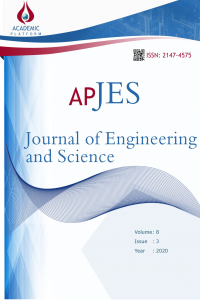Abstract
In jewelry workshops, during the production, the gold is accumulated as dust in the working environment. The recovery of these golden micro particles is provided by gold recycle workers. Nitric oxide is formed in a method called “polishing waste” which is the leaching process of gold within aqua regia (mixture of hydrochloric acid and nitric acid) for gold recovery. Nitric oxide is not only found in the working environment but also released into the atmosphere. Wet scrubbing with sodium hydroxide is used in order to eliminate NO gas, formed in the process. Since the water solubility of NO gas is very low, the wet scrubbing filtration system made with alkali materials is not sufficient alone. In this study, nitrous oxide gas (N2O), which is harmless to environment and human health, is given off to the atmosphere by reducing NO formation with addition of solid sulfamic acid to aqua regia. It was observed that NO parameter was zero and nitric oxide was not present at all during the process.
References
- [1] Who.int. (2019). Ten health issues WHO will tackle this year. https://www.who.int/emergencies/ten-threats-to-global-health-in-2019 [Erişim zamanı;Ağustos,10, 2019].
- [2] Toraks.org.tr. (2019). Nefes Alamıyoruz: Partikül Madde Emisyonları Açısından Türkiye’de Hava Kirliliği | Türk Toraks Derneği. https://www.toraks.org.tr/news.aspx?detail=3772 [Erişim zamanı;Ağustos,13, 2019].
- [3] Odası, T. (2019). { HAVA KİRLİLİĞİ RAPORU } TMMOB Çevre Mühendisleri Odası. Cmo.org.tr.http://www.cmo.org.tr/genel/bizden_detay.php?kod=97401&sube=0 [Erişim zamanı;Temmuz,18, 2019].
- [4] Earnshaw, A. and Greenwood, N. (2005). Chemistry of the elements. Amsterdam: Elsevier.
- [5] Vural, N. (2005). Toksikoloji. Ankara Üniversitesi Eczacılık Fakültesi.
- [6] Mansouri, A. (1985). Methemoglobinemia. The American Journal of the Medical Sciences, 289(5), pp.200-209.
- [7] Who.int. (2019). WHO | Air quality guidelines - global update 2005. https://www.who.int/phe/health_topics/outdoorair/outdoorair_aqg/en/ [Erişim zamanı;Ağustos,22, 2019].
- [8] Warneck, P. (1999). Ch.9 Nitrogen Compounds in the Troposhere. In: Chemistry of the natural atmosphere, 71st ed. Elsevier.
- [9] Çetin, Ş. and Ayberk, S. (2007). Azot Oksit Emisyonları ve Çevresel Açıdan Değerlendirilmesi. Endüstri Otomasyon Dergisi, 118, pp.22-26.
- [10] Richter, A. (2009). Nitrogen oxides in the troposphere – What have we learned from satellite measurements?. The European Physical Journal Conferences, 1, pp.149-156.
- [11] J. H. Withgott and S. R. Brennan, “Environment: The Science behind the Stories,” Pearson. https://www.slideserve.com/tyne/lecture-outlines-chapter-17-environment-the-science-behind-the-stories-4th-edition-withgott [Erişim zamanı;Eylül,11, 2019].
- [12] Erdem, B. (2006). İkincil Kaynaklardan Altın Geri Kazanımı ve Rafinasyon Prosesinin Optimizasyonu. Kimya-Metalürji Fakültesi, (yüksek lisans tezi). İTÜ, İstanbul/Türkiye.
- [13] Gündeş, A. (2015). Altın Üretiminde Kullanılan Kral Suyundan Sıvı Gübre Üretimi. Kahramanmaraş Sütçü İmam Üniversitesi Mühendislik Bilimleri Dergisi, 18(2), p.67.
- [14] Kuropka, J. (2011). Removal of nitrogen oxides from flue gases in a packed column. Environment Protection Engineering, 37(1), pp.13-22.
- [15] Lyne, E.G., Berryman, A.B., Evans, C.M., Sampat, S., Jensen-Holm, H., “Advances in NOx removal in smelter acid plants”, Proc. Int. Seminar for New Initiatives in the Mining Sector) Chilean Copper Commission, Santiago (2002).
Abstract
Kuyumcu atölyelerinde, mücevherat yapımı süresince, çalışma ortamında toz olarak biriken altınının geri dönüşümü ramatçılar tarafından sağlanmaktadır. Altın geri dönüşümünün kral suyuyla (hidroklorik asit ve nitrik asit karışımı) yapıldığı cila ramatı metodunda oluşan azot oksit(NO), hem çalışma ortamında bulunmakta hem de atmosfere salınmaktadır. Bu tesislerde oluşan NO gazının giderilmesi için kostikle yıkama yapılmaktadır. NO gazının suda çözünürlüğü çok düşük olduğu için, alkali maddelerle yapılan sulu-yıkamalı filtreleme sistemi tek başına yeterli olmamaktadır. Bu çalışmada yapılan cila ramatı prosesinde, kral suyuna eklenen katı sülfamik asit ile NO oluşumu azaltılarak, ortama çevre ve insan sağlığı için zararsız olan nitröz oksit gazı(N2O) verilmiştir. Yapılan ölçümlerde NO parametresinin sıfır olduğu ve ortamda proses boyunca hiç bulunmadığı gözlemlenmiştir.
References
- [1] Who.int. (2019). Ten health issues WHO will tackle this year. https://www.who.int/emergencies/ten-threats-to-global-health-in-2019 [Erişim zamanı;Ağustos,10, 2019].
- [2] Toraks.org.tr. (2019). Nefes Alamıyoruz: Partikül Madde Emisyonları Açısından Türkiye’de Hava Kirliliği | Türk Toraks Derneği. https://www.toraks.org.tr/news.aspx?detail=3772 [Erişim zamanı;Ağustos,13, 2019].
- [3] Odası, T. (2019). { HAVA KİRLİLİĞİ RAPORU } TMMOB Çevre Mühendisleri Odası. Cmo.org.tr.http://www.cmo.org.tr/genel/bizden_detay.php?kod=97401&sube=0 [Erişim zamanı;Temmuz,18, 2019].
- [4] Earnshaw, A. and Greenwood, N. (2005). Chemistry of the elements. Amsterdam: Elsevier.
- [5] Vural, N. (2005). Toksikoloji. Ankara Üniversitesi Eczacılık Fakültesi.
- [6] Mansouri, A. (1985). Methemoglobinemia. The American Journal of the Medical Sciences, 289(5), pp.200-209.
- [7] Who.int. (2019). WHO | Air quality guidelines - global update 2005. https://www.who.int/phe/health_topics/outdoorair/outdoorair_aqg/en/ [Erişim zamanı;Ağustos,22, 2019].
- [8] Warneck, P. (1999). Ch.9 Nitrogen Compounds in the Troposhere. In: Chemistry of the natural atmosphere, 71st ed. Elsevier.
- [9] Çetin, Ş. and Ayberk, S. (2007). Azot Oksit Emisyonları ve Çevresel Açıdan Değerlendirilmesi. Endüstri Otomasyon Dergisi, 118, pp.22-26.
- [10] Richter, A. (2009). Nitrogen oxides in the troposphere – What have we learned from satellite measurements?. The European Physical Journal Conferences, 1, pp.149-156.
- [11] J. H. Withgott and S. R. Brennan, “Environment: The Science behind the Stories,” Pearson. https://www.slideserve.com/tyne/lecture-outlines-chapter-17-environment-the-science-behind-the-stories-4th-edition-withgott [Erişim zamanı;Eylül,11, 2019].
- [12] Erdem, B. (2006). İkincil Kaynaklardan Altın Geri Kazanımı ve Rafinasyon Prosesinin Optimizasyonu. Kimya-Metalürji Fakültesi, (yüksek lisans tezi). İTÜ, İstanbul/Türkiye.
- [13] Gündeş, A. (2015). Altın Üretiminde Kullanılan Kral Suyundan Sıvı Gübre Üretimi. Kahramanmaraş Sütçü İmam Üniversitesi Mühendislik Bilimleri Dergisi, 18(2), p.67.
- [14] Kuropka, J. (2011). Removal of nitrogen oxides from flue gases in a packed column. Environment Protection Engineering, 37(1), pp.13-22.
- [15] Lyne, E.G., Berryman, A.B., Evans, C.M., Sampat, S., Jensen-Holm, H., “Advances in NOx removal in smelter acid plants”, Proc. Int. Seminar for New Initiatives in the Mining Sector) Chilean Copper Commission, Santiago (2002).
Details
| Primary Language | Turkish |
|---|---|
| Subjects | Engineering |
| Journal Section | Articles |
| Authors | |
| Publication Date | September 30, 2020 |
| Submission Date | October 14, 2019 |
| Published in Issue | Year 2020 Volume: 8 Issue: 3 |


